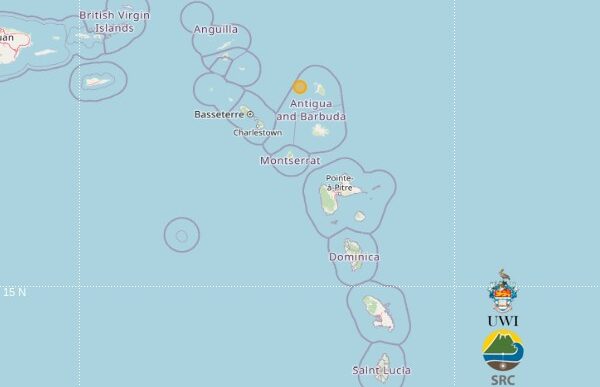Earthquake experts recorded a 3.8 magnitude earthquake this morning (26 February) at a distance of 97 kilometres north of Montserrat.
The University of West Indies Seismic Research Centre detected the tremors at 11.15am at a depth of 52 kilometres, according to a post on its Facebook page.
The epicentre of the earthquake was closest to Antigua and Barbuda, just 65 km north-north west of Saint John’s, and 85 km north east of Basseterre in Saint Kitts and Nevis.
According to the Richter scale, an earthquake of a magnitude between 3 and 3.9 is ‘slight’ and it is: “Often felt by people, but very rarely causes damage.”
There are more than 100,000 of this scale of earthquake recorded throughout the world each year.
Eastern Caribbean earthquakes
The UWI Seismic Research Centre operates more than 60 seismic stations on islands throughout the Eastern Caribbean and has access to about 100 more from other regional agencies.
Continuous data from nearly all the stations are transmitted directly to its office in St Augustine, Trinidad, for real time processing and analysis, its website says.
Most of the earthquakes it records in the eastern Caribbean are either tectonic or volcanic in origin, the website adds.
“Tectonic earthquakes are generated when plates move as accumulated strain energy is released. Volcanic earthquakes are generated by the movement of magma within the lithosphere (rock).
“Since magma is less dense than the surrounding rock, it rises to the surface, breaking the rock as it moves, thereby generating earthquakes.
“In fact, more than 75% of the world’s earthquakes occur at convergent plate boundaries. The countries of the Eastern Caribbean are therefore, highly susceptible to earthquakes.”
Anyone who felt today’s earthquake can leave feedback on the UWI Seismic Research Centre website here.
During and after
According to the UWI Seismic Research Centre, there are several steps to take during an earthquake:
- Stay calm. Do not panic. Be alert.
- If inside, stay inside. Do not run out of the building.
- If inside, get under a sturdy desk, table or bed and hold on. Do not use elevators or stairs. Move away from windows, mirrors, glass doors, pictures, bookcases, hanging plants and heavy objects.
- If outside and there are no obvious signs of danger nearby, stay there.
- If outside, stay away from glass buildings, electricity poles, and bridges.
- If in a vehicle, do not stop on or under a bridge.
- Always look out for falling plaster, bricks, lighting fixtures and other objects.
After an earthquake, people should do the following:
- Check for broken gas lines and fires.
- Check utilities and switch them off, if necessary.
- Check your house for serious damage and evacuate if the house seems likely to collapse.
- Be prepared for more earthquakes (aftershocks).
- Stay away from landslide-prone areas.
- Turn on transistor radio for emergency news.
- If possible, check the UWI Seismic Research Centre’s website at www.uwiseismic.com for updates.
Guidance on how to plan and prepare for earthquakes is available on the UWI Seismic Research Centre website here.





